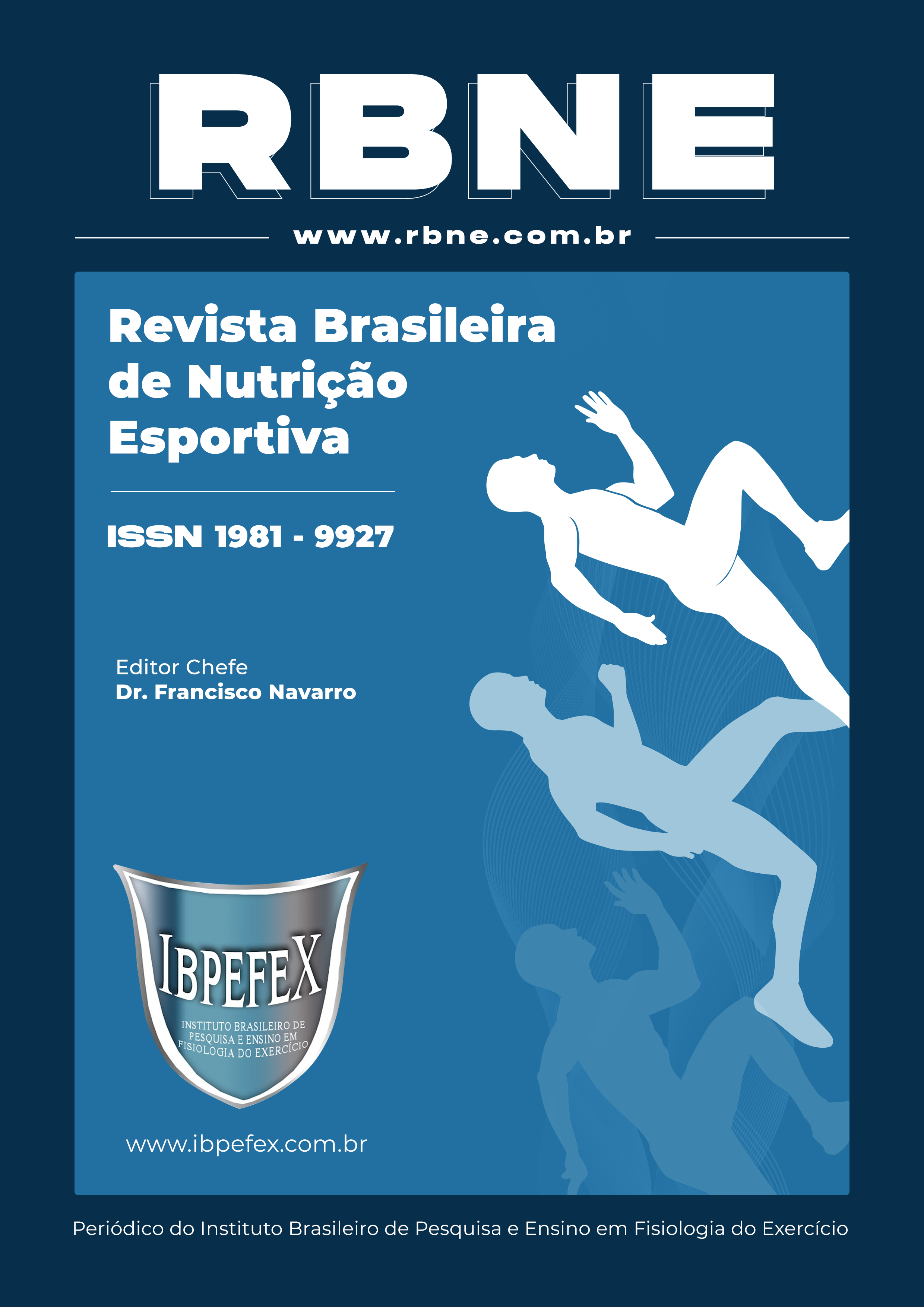Bodybuilding athletes: development of eating disorders after competitions
Abstract
The concept of bodybuilding is based on high performance sports where its objective is focused on physical appearance and hypertrophy. The main objective of the present study was to analyze the development of eating disorders in bodybuilder athletes after competitions, filling the existing gaps in the academic exploration on this subject. This is a cross-sectional and descriptive research. Data collection took place through a Google form, where participants could respond at home, work and even at the gym. Two questionnaires were applied, the first aimed at understanding the athletes' eating routine, habits and behaviors and the second questionnaire the Eating Attitudes Test (EAT-26) used to identify and evaluate irregular eating patterns. The present study showed that the group of bodybuilders analyzed had 18.8% of participants at risk of developing eating disorders based on the questionnaire applied (EAT-26), a significant percentage when compared to the total sample, in addition to demonstrating possible tendencies towards less healthy eating behavior. The manifestation of eating disorders in bodybuilding athletes, before, during or even after competitions is a topic still little explored in the scientific environment, highlighting the need for more detailed and in-depth studies on the subject in question.
References
-Cambraia, R.P.B. Aspectos psicobiológicos do comportamento alimentar. Revista de nutrição. Vol.17. Núm. 2. p.217-225. 2004.
-Chappell, A.J.; Simper, T.; Barker, M. E. Nutritional strategies of high level natural bodybuilders during competition preparation. Journal of the International Society of Sports Nutrition. Vol. 15. Núm. 4. 1-12. 2018.
-Costa, G.M.; Scavone, P.C.; Oliveira, C.S.A.; Manochio-Pina, M. G. Transtornos alimentares e percepção da imagem corporal em culturistas do interior do Estado de São Paulo. Revista Augustus. Vol. 22. Núm. 43. p. 172-181. 2018.
-Cordás, T.A. Transtornos alimentares: classificação e diagnóstico. Archives of Clinical Psychiatry, Vol. 31. Núm. 4. p. 1- 4. 2004.
-Cyrino, E.S.; Santarém, S.J.M.; Maestá, N.; Nardo Jr, N.; Reis, D.A.D.; Morelli, M.Y.G.; Burini, R.C. Perfil morfológico de culturistas brasileiros de elite em período competitivo. Revista Brasileira de Medicina do Esporte. Vol. 14. p. 460-465. 2008.
-Devrim, A.; Bilgic, P.; Hongu, N. Existe alguma relação entre percepção da imagem corporal, transtornos alimentares e distúrbios dismórficos musculares em praticantes de musculação do sexo masculino?. American Journal of Men's Health. Vol. 12. Núm. 5. p. 1746-1758. 2018.
-Efthymiou, D.; Kokokiris, L.; Mesiari, C.; Vassilopoulou, E. O peso corporal ideal percebido exacerba a bulimia e a dieta em atletas de musculação. Relatórios de Toxicologia. Vol. 8. p. 1777-1782. 2021.
-Feijó, F. M.; Bertoluci, M.C. Reis, C. Serotonina e controle hipotalâmico da fome: uma revisão. Revista da Associação Médica Brasileira. Vol. 57. Núm.1. p.74-77. 2011.
-Fiates, G.M.R.; Salles, R.K. Fatores de risco para o desenvolvimento de distúrbios alimentares: um estudo em universitárias. Revista de Nutrição. Vol. 14. p. 3-6. 2001.
-Gibim, K.C.R.; Pinheiro, L.H.N.; Castro, C.; Pinheiro, A.M.; Souza, V.B. Síndromes de alteração de percepção em atletas fisiculturistas. Corpoconsciência. p. 12-19. 2017.
-Helms, E.R.; Aragon, A.A.; Fitschen, P.J. Evidence-based recommendations for natural bodybuilding contest preparation: nutrition and supplementation. Journal of the International Society of Sports Nutrition. Vol.11. Núm. 20. p.1-20. 2014.
-Mallmann, L.B.; Alves, F.D. Avaliação do consumo alimentar de fisiculturistas em período fora de competição. Revista Brasileira de Nutrição Esportiva. São Paulo. Vol. 12. Núm. 70. p. 204-212. 2018.
-Nieuwoudt, J.E.; Zhou, S.; Coutts, R.A.; Booker, R. Symptoms of muscle dysmorphia, body dysmorphic disorder, and eating disorders in a nonclinical population of adult male weightlifters in Australia. The Journal of Strength & Conditioning Research. Vol. 29. Núm. 5. p. 1406-1414. 2015.
-Oliveira, F.P.D.; Bosi, M.L.M.; Vigário, P.D.S.; Vieira, R.D.S. Comportamento alimentar e imagem corporal em atletas. Revista Brasileira de Medicina do Esporte. Vol. 9. p.348-356. 2003.
-Panza, V.P.; Coelho, M.S.P.H.; Di Pietro, P.F.; Assis, M.A.A.D.; Vasconcelos, F.D.A.G.D. Consumo alimentar de atletas: reflexões sobre recomendações nutricionais, hábitos alimentares e métodos para avaliação do gasto e consumo energéticos. Revista de Nutrição. Vol. 20. p. 681-692. 2007.
-Paula, B.G.; Barbosa, L.S. Prevalência de transtornos alimentares em atletas: uma revisão de literatura. 2021. TCC. Pontifícia Universidade Católica de Goiás (PUC-GOIÁS). 2021.
-Rodrigues, T.M.; Oliveira, A.V. Uma revisão de literatura sobre a dieta de fisiculturistas. TCC Graduação Curso de Nutrição, Pontifícia Universidade Católica-PUC de Goiânia. Goiás. 2020.
-Soihet, J.; Silva, A.D. Efeitos psicológicos e metabólicos da restrição alimentar no transtorno de compulsão alimentar. Nutrição Brasil. São Paulo. Vol.18. Núm.1. p.1-4. 2019.
Copyright (c) 2023 Monalisa Bezerra Vieira Lantyer, Renata Eliza Barbosa Pietschmann, Dayanne da Costa Maynard

This work is licensed under a Creative Commons Attribution-NonCommercial 4.0 International License.
Authors who publish in this journal agree to the following terms:
- Authors retain the copyright and grant the journal the right of first publication, with work simultaneously licensed under the Creative Commons Attribution License BY-NC which allows the sharing of the work with acknowledgment of the authorship of the work and initial publication in this journal.
- Authors are authorized to enter into additional contracts separately for non-exclusive distribution of the version of the work published in this journal (eg, publishing in institutional repository or book chapter), with acknowledgment of authorship and initial publication in this journal.
- Authors are allowed and encouraged to post and distribute their work online (eg, in institutional repositories or on their personal page) at any point before or during the editorial process, as this can bring about productive change as well as increase impact and impact. citation of published work (See The Effect of Free Access).






